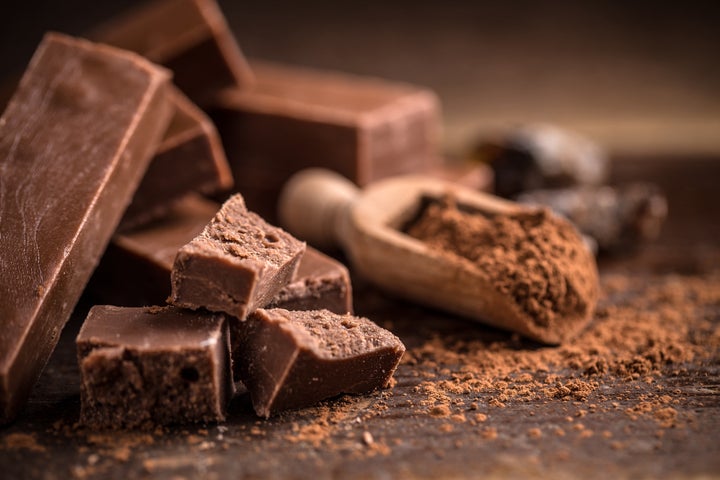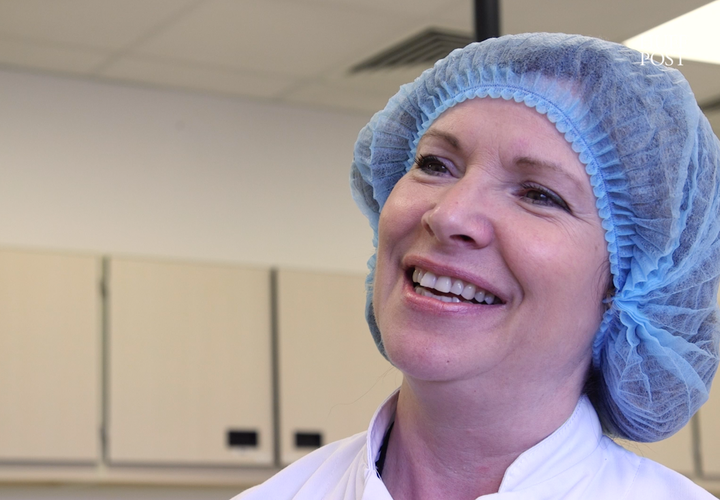Prepare to turn green with envy: HuffPost UK was offered a sneak peek inside a chocolate laboratory, where professional tasters sniff, bite and chomp to make sure the goods taste delicious.
Walking into Reading Science Centre, where the Mondelez lab is based, it’s hard to think this is where chocolate tasters come to work. You half expect Willy Wonka-esque decor, cocoa smells wafting down corridors and wacky scientific equipment. Instead, you’re met with stark white rooms, lab coats and hair nets.
Caroline Robbins is a sensory technician for the company and has been helping to perfect their chocolate recipes for almost six years now. Think of some of the British chocolate classics: Terry’s Chocolate Orange and Cadbury Dairy Milk.
When I ask her if many people are envious of her job, she laughs: “Lots of people are jealous of my job and lots of people’s children are jealous too.”

Robbins previously worked as a chocolate taster in the company, and before that, in a high street bank. The first time she saw the role advertised in the newspaper she thought it was a hoax but, eager to get back to work after having a baby, she decided to apply anyway.
“I couldn’t believe there was a job out there like that,” she recalled.
After being called in for an interview, her tastebuds served her well and she was offered the job.
A professional chocolate taster has to sample many of Mondelez’s chocolate brands - from Dairy Milk Marvellous Creations to Aero Bubbly - and then deliberate whether they are good enough to be sold to consumers.
Discussing a typical day’s work, Robbins explained: “When new projects (chocolate samples) come in to us, the tasters will gather in our discussion rooms, they’ll be presented with different samples and they’ll talk about them and create a language for that sample.”
The ‘language’ is a technical term for the descriptions that are given to the chocolate, such as ‘creamy’ or ‘sweet’. Depending on the chocolate sample, panellists will devise new attributes to describe what they’re tasting.
There are 12 tasters in a panel, and the idea is that by the end of a session, at least seven of those tasters will agree on the attributes of that particular chocolate sample. Each panel is moderated by a panel leader - a scientist - who uses their experience to help the group come to a conclusion.

“We don’t tell our panellists anything about the chocolate they’re tasting,” explained Robbins. “All they know is what they see.”
If you think it’s a walk in the park, you’re terribly wrong, in fact it’s actually very difficult to describe chocolate beyond ‘sweet’, ‘creamy’ and ‘chocolatey’ - take it from one who knows.
Here’s just a small example of how deep the panellists delve into the world of flavour: if one of them were to taste vanilla in their sample, they would then have to go on to determine whether it’s a sweet vanilla (like an ice cream) or more medicinal like a vanilla pod.
After an hour-long session of devising attributes, the tasters go and sit in individual booths (reminiscent of taking your driving theory test) and, one by one, taste the chocolate samples - cleansing their palette between each sample. Using iPads, the tasters then give the chocolate samples - presented in plain white pots - a score.
The sessions last for two hours and take place once a week. It’s a part-time role, but Robbins believes it’s incredibly valuable. After all, if it doesn’t get past the panellists, it doesn’t get made.
Chocolate tasting relies heavily on taste, but surprisingly, it’s also incredibly reliant on smell too.
Afsha Chugtai, group leader at Reading, explained: “The way we taste is a little bit more complex than you’d think. Obviously we have our tastebuds that are located within our mouth, the things like salt, sweet, bitter, sour and umami.
“But actually three quarters of what we perceive as flavour is through aroma. So when we’re eating, the molecules are being released and they take a journey through our nasal cavity and come up to an area behind the bony bit of our nose called the olfactory bulb. And that’s where a lot of the flavours are perceived.”
She added: “If you have a cold, for example, you’ll know that you can’t taste things well. The reason behind that is because your nose is so blocked by mucus that the molecules can’t get up to the olfactory bulb.”
To avoid disrupting their senses - and the senses of fellow panellists - chocolate tasters must avoid drinking strong coffee and tea before sessions. They’re also told to avoid smoking and eating strong food the night before. Wearing fragrances, lipsticks and lip balms is prohibited and even strong-smelling fabric softener is taken into account, as it can affect the way tasters assess aroma.
When asked whether there are any health concerns around the job - specifically diabetes concerns due to the sugar content - Robbins said tasters only try 8-10 samples a day (that’s one chunk of chocolate per sample). They aren’t required to eat the whole sample - which means they realistically eat about five chunks in a day - and some people are even given spit cups if they’re really concerned about their health.
Now for the the golden question: how can you become a chocolate taster?
Mondelez released a job vacancy at the beginning of the year for a chocolate tasting panellist and - after being bombarded with applications from all over the world (5,798 to be precise) - they had to close the position earlier than expected. But that’s not to say your chances are scuppered, in fact they tend to change the panels halfway through the year.
“When we recruit new people, the process we put the candidates through is all about assessing whether they have the ability to discriminate between samples,” explained Robbins.
This process seems relatively simple on the face of it. You’re led into a room with separate booths and three samples are passed through to you from the laboratory. The samples are presented in white pots: one of them is the reference pot, another sample matches that pot and the other sample is different. It’s your job to tell them apart.
On the face of it, it seems relatively simply, but it’s actually very hard. Take it from someone who got 0% on their screening test. I tasted three separate chunks of chocolate, cleansing my palette between them with a cracker, and guess what? They all tasted like creamy, sweet chocolate - with the faintest hint of plastic (yes, I wrote that down).
Another test asked me to differentiate between the three types of chocolate by simply smelling them. I failed miserably.
The final test was with dark chocolate - in my personal opinion, the devil’s confectionery - and aside from being able to say ‘it’s bitter’, I was unable to differentiate between the samples.
As Robbins put it: “There’s nothing you can do to train for this job. It’s all about how many taste buds somebody has at the end of the day.”
Needless to say, mine are in trouble.
